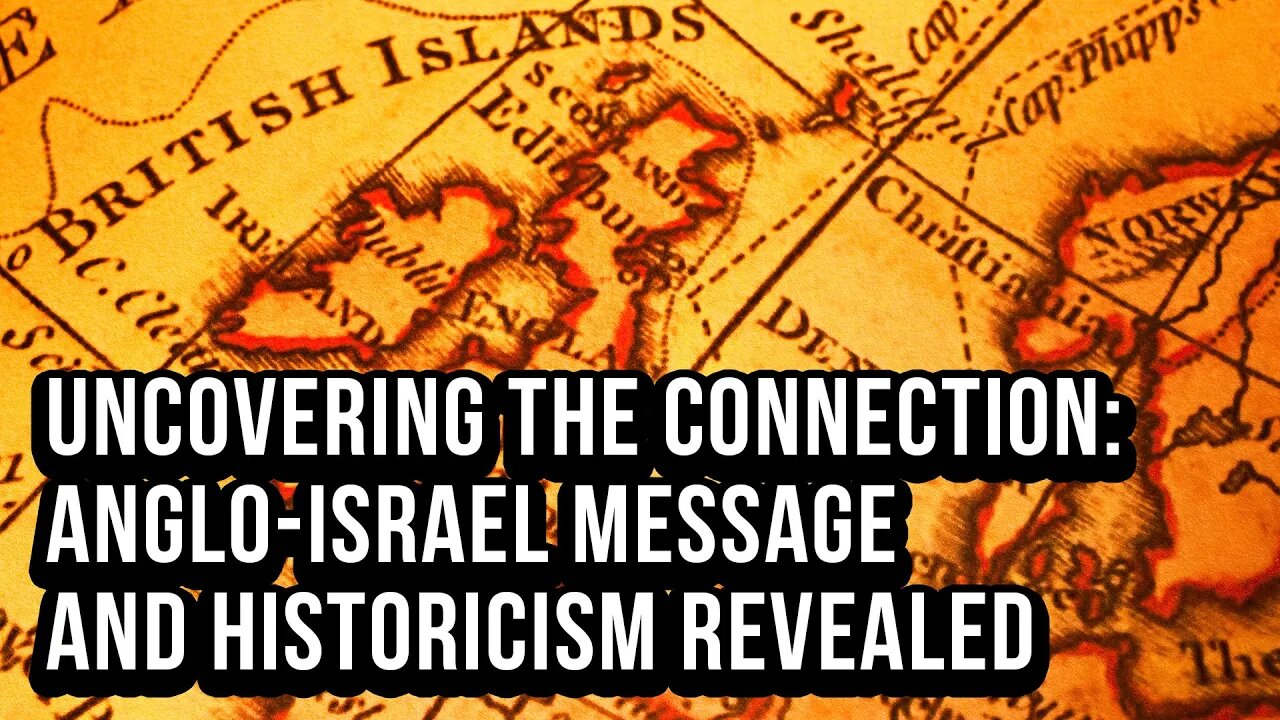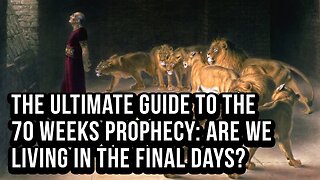Premium Only Content

Historicism and Anglo Israel
Recently, Robert Caringola and I created a series of six programs discussing Historicism and the 70 weeks of Daniel, found in Daniel Chapter Nine. I would like to further elaborate on Historicism in connection with the Anglo-Israel message. Do they complement each other? My answer is a resounding yes.
The 70 weeks of Daniel, or the 490-year period, refers only to the Judah Nation and the arrival of Christ at the perfect time. This includes His water baptism, the beginning of His ministry, and His crucifixion resurrection. This period ended at the stoning of Stephen and the entrance of Apostle Paul into the gospel story. What about the House of Israel, which represented all 13 tribes scattered abroad and commonly referred to as the lost ten tribes?
All 13 tribes were dispersed throughout the Mediterranean world, into northwestern Europe, and the British Isles. James, in his book, acknowledges the existence of all 12 tribes in James 1:1, writing to the "12 tribes which are scattered abroad." Apostle Peter also recognizes their existence in 1 Peter 1:1, addressing the "strangers scattered throughout Pontus, Galatia, Cappadocia, Asia, and Bithynia, elect according to the foreknowledge of God the Father." They were chosen beforehand, as God had chosen Israel in the Old Testament.
During his ministry and three missionary journeys, Apostle Paul preached to Israelites. It is evident when reading the books of Romans, Galatians, Ephesians, and Corinthians that he is speaking solely to Israelites. The teachings would not hold the same meaning for non-Israelite strangers or heathens. In Acts 26:6-7, Paul speaks before King Agrippa, stating that he stands judged for the hope of the promise made by God unto their Israelite forefathers. He believes that the promises made to these forefathers will be fulfilled in the 12 tribes living during the first century and beyond, down to us.
The belief in the amalgamation theory, wherein the tribes were absorbed into the heathen nations and disappeared into oblivion, is a significant misconception, a lie created by those who do not believe in the Anglo-Israel message. They need to come up with an excuse to justify their disbelief.
The question arises: how did the gospel reach Europe and Great Britain? In Acts 13:46, Paul and Barnabas boldly state that it was necessary for the Word of God to be spoken first to the Jews in Judea. However, seeing that the Jews rejected the Word, they turned to the Gentiles. Paul reiterates this in Acts 18:5-6. The Gentiles he refers to are the House of Jacob or the tribes of Israel, as mentioned in Isaiah 49. Paul was sent to preach to the House of Israel, making him a missionary to the Gentiles.
There is historical evidence that Paul traveled to Great Britain, taking the gospel to the Israelites there. This supports the idea that the children of Israel are the Anglo-Saxon, Germanic, and Scandinavian-related people. The Book of Revelation's historical setting takes place in Europe among the children of Israel.
In Revelation Chapter 4, a heavenly scene with the throne of God is depicted. The chapter mentions four living creatures surrounding the throne: a lion, a man, a calf, and a flying eagle. These creatures symbolize the brigades of the tribes of Israel. The lion represents Judah, Issachar, and Zebulun; the man symbolizes Reuben, Simeon, and Gad; the calf stands for Ephraim, Manasseh, and Benjamin; and the eagle signifies Dan, Asher, and Naphtali. These symbols represent the encampment of the tribes around the tabernacle, indicating that the heavenly scene involves all 12 tribes of Israel.
In Revelation Chapter 7, the sealing of the tribes is mentioned. In verses 2-8, an angel with the seal of the living God is seen ascending from the east, instructing the four angels not to harm the earth, sea, or trees until the servants of God have been sealed on their foreheads. This sealing represents God's protection and ownership over His chosen people, the Israelites. The chapter goes on to list the 12 tribes that receive this seal, reaffirming their existence and significance in the Book of Revelation.
As we examine the Book of Revelation and its historical context, it becomes clear that the Anglo-Israel message and Historicism are indeed connected. The Israelites, scattered throughout the Mediterranean world, northwestern Europe, and the British Isles, play a crucial role in the events described in the Book of Revelation. Through the ministries of Paul and other apostles, the gospel reached these regions, and the prophecies found in the scriptures were fulfilled among the children of Israel.
In conclusion, the Anglo-Israel message and Historicism complement each other, providing a more comprehensive understanding of the scriptures and the role of the Israelite tribes in history and prophecy. By recognizing this connection, we can gain a deeper appreciation for the divine plan and the fulfillment of God's promises to His chosen people.
-
 28:31
28:31
Truth in History
2 years ago70 Weeks and Logical Conclusions - Part 6
3052 -
 58:42
58:42
The Amber May Show
9 hours agoWomen Of Rumble 04-15-25
2.37K -
 4:49
4:49
The Official Steve Harvey
1 day agoSteve Harvey's Motivational Talks 💭✨ Dream Big, Work Hard, and Make It Happen! ✨💭
37.9K6 -
 LIVE
LIVE
RaikenNight
1 hour agoTime To Go On A Hunt
80 watching -
 2:10:55
2:10:55
Purrfect Pixie's Cozy Spot
3 hours agoPixie Plays: World of Warcraft Cataclysm Classic: Dragon Soul Raid
33 -
 LIVE
LIVE
AlaskanBallistics
2 hours agoI love this Gun PodCast #26
82 watching -
 LIVE
LIVE
yellow_1ron
3 hours agoFIRST EVER RUMBLE STREAM | MARVEL RIVALS | WARZONE | JOIN UP!!!
64 watching -
 30:08
30:08
QNewsPatriot
10 hours ago(4/14/2025) | AUDIO CHAT 160 | SG Sits Down w/ CA Patriots "The Shasta Five": Election Security Efforts in Deep Blue California
9.71K4 -
 LIVE
LIVE
Anthony Rogers
1 day agoEpisode 361 - Stargates & Ancient Civilizations
69 watching -
 1:00:55
1:00:55
BonginoReport
6 hours agoCalifornia BROKE After Bankrolling Illegals’ Healthcare - Nightly Scroll w/ Hayley Caronia (Ep.27)
101K81